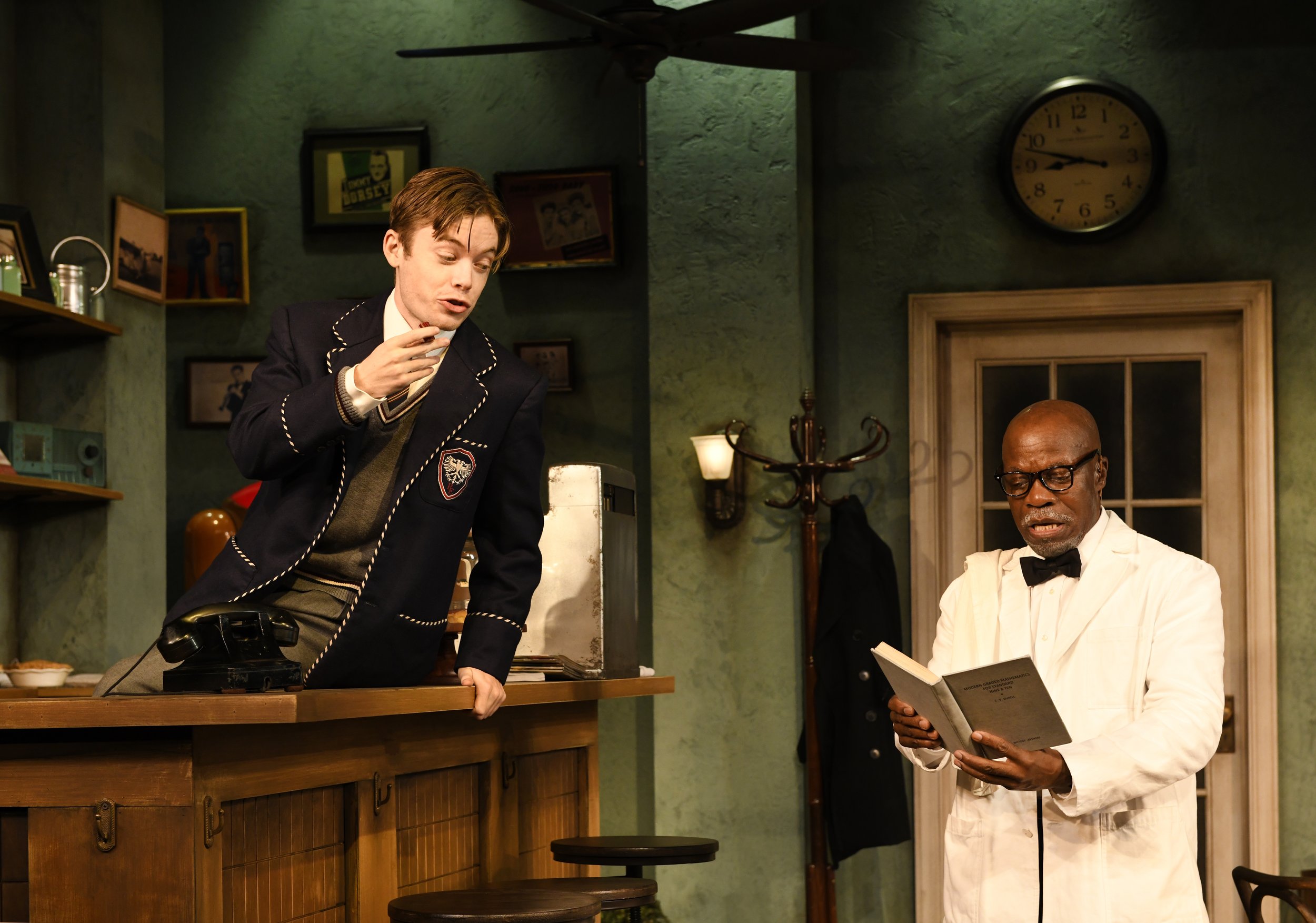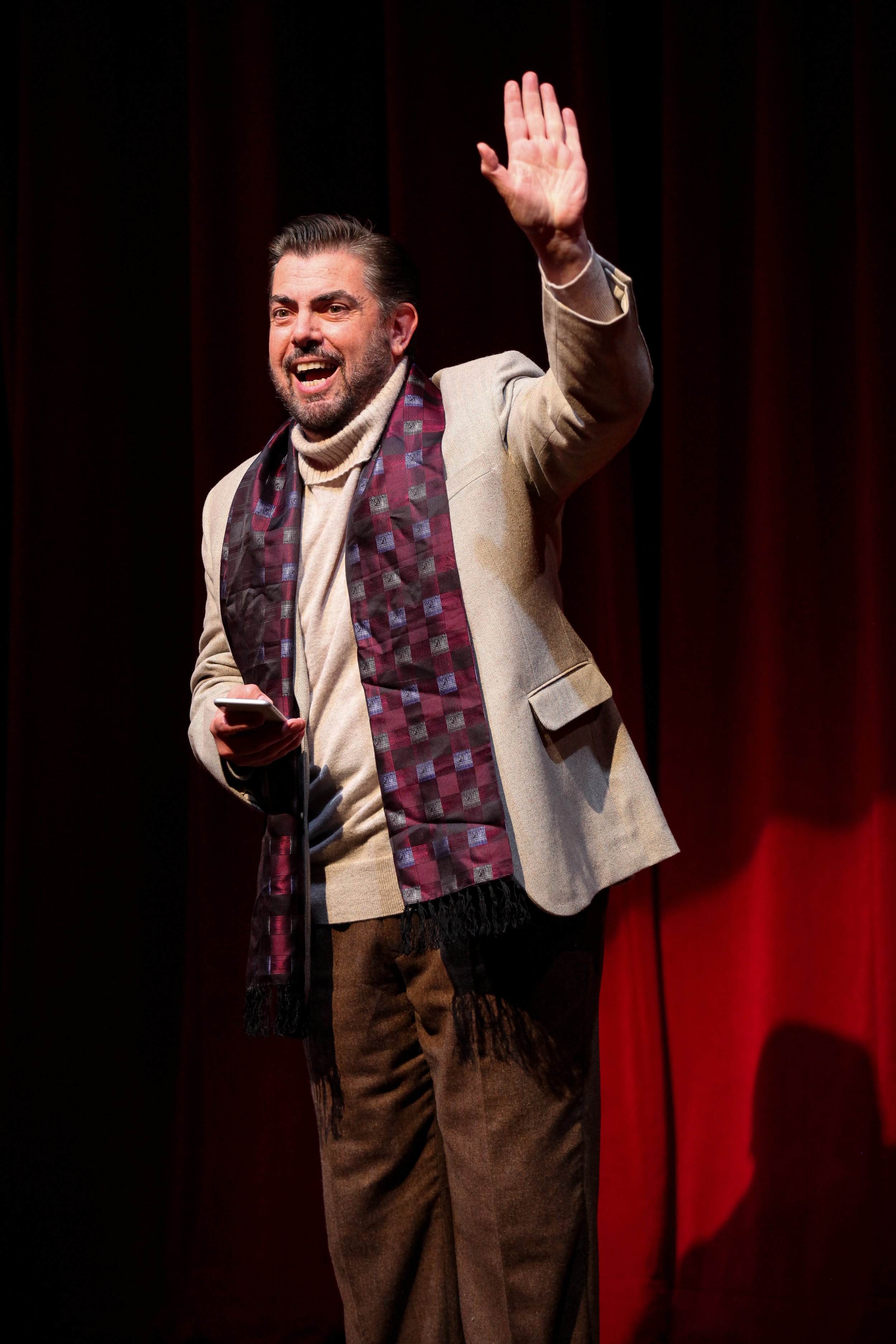
STAGE AS WE KNOW IT
Arthur Storch, Eli Wallach and Anne JacksonTwice Around the Park. Season: 1980 – 1981. Director: Arthur Storch.
Arthur Storch chose Shakespeare’s madcap The Comedy of Errors to inaugurate the new Archbold Theatre. The first performance on November 13, 1980, marked, as Jim Clark once noted, “the beginning of Syracuse Stage as we know it.” The opening night program contained congratulations and good wishes from luminaries of the theatre world and beyond. Academy Award winning actor Jack Lemmon wrote, “My love and gratitude always, and my congratulations on the great job you’ve done with Syracuse Stage.” Joseph Papp, founder The Public Theatre in New York, noted: “In these times, the opening of the John D. Archbold Theatre represents an act of affirmation and boldness.” And Kitty Carlisle Hart added, “We are all looking forward to many wonderful productions in this marvelous new facility.” Hart would in fact appear twice at the theatre in Old Time Radio fundraisers. Several others who sent their congratulations would later appear in full productions in the new Archbold Theatre, including Jean Stapleton, Eli Wallach, and Anne Jackson.
The seasons that followed would come to fulfill Storch’s vision for Syracuse Stage. Of the 75 mainstage productions mounted between 1980 and 1992, the year of Storch’s retirement from Stage, many rank among the most popular and artistically successful in the theatre’s history. The famous and soon-to-be famous joined scores of dedicated work-a-day actors and artists to consistently deliver a level of professionalism that established Stage’s reputation as a standout cultural leader in Central New York and a vital part of the American Theatre.
Among the famous were Eli Wallach and Anne Jackson, longtime friends of Storch, who made Syracuse Stage’s first Broadway transfer with Twice Around the Park (1981 – 1982). The show moved to the Kennedy Center in Washington, DC, before opening at the Cort Theatre in New York. (Forty years later Stage would realize it’s second Broadway transfer when Thoughts of a Colored Man [2019] would be among the first plays to reopen Broadway post-pandemic in 2021. A third transfer, the musical How to Dance in Ohio [2022], is scheduled to open at Broadway’s Belasco Theatre in December of this year.)
Kate Mulgrew as Maggie in Cat on a Hot Tin Roof. Season: 1982-1983
Broadway star John Cullum’s turn as the title character in Edmond Rostand’s Cyrano de Bergerac (1983-1984) dazzled local audiences before embarking on a successful national tour including a stop in Boston where longtime Boston Globe critic Kevin Kelly proclaimed: “The recent Royal Shakespeare Company version of Cyrano de Bergerac has been bested.” High praise indeed considering the RSC cast included Derek Jacobi, Sinead Cusack, and Pete Postlethwaite. Film and television actors Audra Lindley and James Whitmore appeared in the world premiere of William Gibson’s Handy Dandy. Kate Mulgrew played Maggie in Tennessee Williams’s Cat on a Hot Tin Roof, Roma Downey took on Liza Doolittle in George Bernard Shaw’s Pygmalion, Barbara Barrie starred in the world premiere of Fugue, and Tony Lo Bianco reprised his Emmy-winning performance as Fiorello LaGuardia in Hizzoner! Playwright and actor John Henry Redwood III gave a towering performance as Troy Maxon in August Wilson’s Fences. Directed by Claude Purdy and featuring Marion McClinton and Delores Mitchell, it was the first Stage production of a Wilson play.
In the 1970s, three-time Emmy Award winner Jean Stapleton became a television star for her portrayal of Edith Bunker in the sitcom All in the Family. An accomplished actor, her stage career began in the 1950s. In the 1983 – 1984 season, she was cast in Stage’s production of George Kelly’s The Show-Off, directed by her husband William H. Putch. On the Monday before opening, Putch passed away suddenly. As Jim Clark recalled, while the theatre was prepared to cancel the opening or even the entire run of the show, Stapleton proposed an alternative. Asking to meet with the full company before the scheduled first preview, she said that the best way to honor her husband would be carry on. It was what he would have wanted, she explained. The Show-Off sold out its entire run. Stapleton returned to Stage in the 2000 – 2001 season to portray Eleanor Roosevelt in the one person show Eleanor: Her Secret Journey by Rhoda Lerman. Again, the entire run sold out.
L to R: Stephen Lang, John Carpenter in Death of a Salesman.
Season: 1982-1983
Throughout the years, Stage has featured numerous performers who would achieve significant notoriety later in their careers. Stephen Lang played Biff Lohman in Death of Salesman (1982 – 1983) on his way to a career that would land him on Broadway before launching him the distant moon of Pandora in James Cameron’s Avatar. Ray Wise and Raul Aranas rocked Sam Shepard’s Tooth of the Crime (1982 – 1983) as the characters Hoss and Doc. Wise would appear in such films as Twin Peaks and RoboCop. Aranas has worked extensively in television on numerous shows including The Blacklist, Blue Bloods, Law & Order, Elementary, Madam Secretary, and many more. John Spencer and Jacqueline Knapp figured in one of Stages more controversial productions by appearing nude in Frankie and Johnny in the Clair de Lune (1987 – 1988). Knapp has enjoyed a long career on Broadway and in television. Spencer would go onto significant roles in TV’s L.A. Law and The West Wing. Before earning two Tony Awards for his portrayal of Prior Walter in Tony Kushner’s Angels in America, Part I: Millennium Approaches and Angels in America, Part II: Perestroika, Stephen Spinella would appear in Stage’s The Miser and 7 by Beckett (both 1987 – 1988). Also in The Miser cast was a young actor named Mary Louise Parker who would later win a Tony Award for Proof and two Golden Globe Awards, one for the mini-series version of Angels in America and one for the series Weeds.
J. Smith-Cameron in Romeo and Juliet.
Season: 1985-1986
Of course, for any of these artists, Syracuse Stage was but one stop among many during long and successful careers. For one performer, though, her time at Stage was impactful. J. Smith-Cameron has in recent years enjoyed extraordinary success and fame playing Gerri Kellerman in the hit series Succession. In the 1985 – 1986 season, Storch cast her as Juliet in Romeo and Juliet. She was 28. Her performance was “stunning” according to Stage’s director of production operations Don Buschmann, who was the show’s stage manager. Soon after, Smith-Cameron would originate the role of Babe in Beth Henley’s Crimes of the Heart on Broadway and in 1991 she would earn a Tony nomination for Our Country’s Good. In April of 2023, Smith-Cameron recalled her Stage experience in an interview with Bustle:
One big milestone was that I got cast as Juliet in Romeo and Juliet. It was at Syracuse Stage, but that was a part I'd always wanted to play. They had been trying to cast a younger person in their early 20s and had not found anyone who could do the verse. That was a very formative experience for me because I remember thinking, "I'm a little bit older than they mean to cast and I'm not going to get this job."
I remember preparing for it the night before and figuring out what I was going to wear and getting in bed and my eyes snapping back open and thinking to myself, "You didn't prepare enough. You didn't prepare like you thought you could get it." And I got right back out of bed and started rehearsing the monologues again in my nightgown. I went in the next day very tired, but I got the part. It wasn't something that would move my career forward in any way that anyone outside looking in would notice, but it was a big turning point for me..
J. Smith-Cameron in Succession.
Succession is an American satirical comedy-drama television series created by Jesse Armstrong that aired on HBO from June 3, 2018, to May 28, 2023
While it is certainly entertaining to recall the “celebrity” connections from seasons past, as noted above the vast majority of the actors and artists who have worked at Syracuse Stage throughout the years are from the ranks of hard-working and dedicated professionals who divide their time between various theatre, film, and television jobs, often working in numerous locations in the course of a year. Sometimes, those actors return to Stage with some frequency. In recent seasons, for instance, Kate Hamill, Jason O’Connell, and Seth Andrew Bridges have appeared in multiple shows. More often though, return visits, if they occur at all, are infrequent, sometimes years apart. One recent instant grabs attention. On that opening night in November 1980, an actor named L. Peter Callender, in the role of Egeon, spoke the very first lines from the new Archbold stage. Forty years later, in the Covid impacted 2020-2021 season, Callender returned to Syracuse Stage as Sam in the online only production of Athol Fugard’s “Master Harold” . . . and the Boys.

Joey Parsons, Jeff Gonzalez, Kate Hamill, and Stephan Wolfert in "Pride and Prejudice" at Syracuse Stage, March 20 through April 7, 2019.

L. Peter Callender in Syracuse Stage's production of "'Master Harold'...and the Boys," streaming on demand June 16 - July 4, 2021

L. Peter Callender and Nick Apostolina in Syracuse Stage's production of "'Master Harold'...and the Boys," streaming on demand June 16 - July 4, 2021

Jason O'Connell in "The Play that Goes Wrong," at Syracuse Stage April 13 - May 1, 2022.

Seth Andrew Bridges and Kate Hamill in the Syracuse Stage production of "Noises Off."

Jason O'Connell and Kate Hamill in "Talley's Folly," the first mainstage production in Syracuse Stage's virtual 2020/2021 season.

Seth Andrew Bridges (sword raised) and company members in Syracuse Stage's production of "The Three Musketeers".

Stephanie Weeks, Jason O'Connell and Drew Hirshfield in "Eureka Day" at Syracuse Stage, Oct. 13 - 31, 2021.

Kate Hamill in "The Play that Goes Wrong," at Syracuse Stage April 13 - May 1, 2022.
In October of 1991, Arthur Storch announced his retirement from Syracuse Stage and the Department of Drama saying simply that it was “time to stop and smell the flowers.” At a press conference, he reflected on his tenure at Stage: “I think what I am most proud of, as far as Syracuse Stage is concerned, is that we created a standard of quality that does not cater to the lowest common denominator. The bottom line has always been: This is the best play and these are the best people; not this play will sell the most tickets.”
Before he left town, however, there was one matter that needed to be addressed. Staff members recall that throughout his tenure, Storch had periodically “threatened” to act in a play. At the time of his retirement announcement, he had not done so. He finally made good on that threat when he appeared with Virginia Kiser in A. R. Gurney’s Love Letters, which he also directed.
Arthur Storch and Virginia Kiser in “Love Letters” Season: 1991-1992
Storch had enduring impact on theatre in Syracuse. The quality of the productions and high standard of professionalism made Syracuse Stage a vital cultural force in Central New York and theatre an important part of the cultural fabric. Storch mixed the classic works of Shakespeare, Ibsen, Chekhov, Shaw, Miller, and Williams with daring and at times controversial productions of Shepard, Beckett, Tremblay, and an array of well and lesser-known contemporary writers from America and abroad. Without always being serious, he made people consider theatre seriously. By any standard, his record as a producer, director, and artistic director is impressive. In short, “he brought a little class to Syracuse,” as one admirer noted when he announced his retirement. In addition, Storch made Syracuse theatre a vibrant part of a broader theatrical community by producing world and American premieres, by taking productions on tour or transferring them to New York or elsewhere, and by supporting the careers of many directors, actors, and designers who found Syracuse Stage an exciting place to work. During his tenure, Syracuse Stage fulfilled the goal of regional theatre. The man who wondered if he could “walk the walk” certainly left a significant impression on East Genesee Street.
Storch also had a transforming and lasting impact on the Department of Drama. As longtime Drama faculty member Gerard Moses recalled, Storch’s arrival was a significant turning point for the Department: “He gave it focus. By introducing ‘The Method’ and training from the Actors Studio he moved the Department forward and shaped it into what it is today.”
In March of 1993, Syracuse Stage and the Department of Drama paid tribute to Storch by renaming the Experimental Theatre in his honor. Since then, it has been known as The Arthur Storch Theatre.
Arthur Storch passed away in March 2013.
New York Times obituary: https://www.nytimes.com/2013/03/11/theater/arthur-storch-theater-director-is-dead-at-87.html














